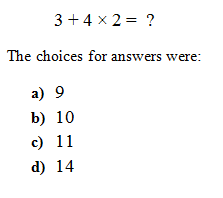 Any math teacher who teaches the Order of Operations is familiar with the phrase, "Please Excuse My Dear Aunt Sally". For the life of me, I don't know who Aunt Sally is or what she has done, but apparently we are to excuse her for the offense. In my math classes, I use "Pale Elvis Meets Dracula After School". Of course both of these examples are mnemonics or acronyms; so, the first letter of each word stands for something. P = Parenthesis, E = Exponents, M = Multiplication, D = Division, A = Addition, and S = Subtraction.
Any math teacher who teaches the Order of Operations is familiar with the phrase, "Please Excuse My Dear Aunt Sally". For the life of me, I don't know who Aunt Sally is or what she has done, but apparently we are to excuse her for the offense. In my math classes, I use "Pale Elvis Meets Dracula After School". Of course both of these examples are mnemonics or acronyms; so, the first letter of each word stands for something. P = Parenthesis, E = Exponents, M = Multiplication, D = Division, A = Addition, and S = Subtraction. I have always taught the Order of Operations by just listing which procedures should be done first and in the order they were to be done. But after viewing a different way on Pinterest, I have changed my approach. Here is a chart with the details and the steps to "success" listed on the right.
When expressions have more than one operation, follow the rules for the Order of Operations:
- First do all operations that lie inside parentheses.
- Next, do any work with exponents or radicals.
- Working from left to right, do all the multiplication and division.
- Finally, working from left to right, do all the addition and subtraction.
The correct answer is 11 because you multiply the 4 x 2 and then add the 3, but can you guess which answer most of my students chose? That's right - 14! From that year on, the Order of Operations became a priority in my classroom. Is it a priority in yours? Should it be?
-----------------------------------------------------------------------------
I have a product in my store entitled: Order of Operations - PEMDAS, A New Approach. This ten page resource includes a lesson plan outline for introducing PEMDAS, an easy to understand chart for the students, an explanation of PEMDAS for the student as well as ten practice problems. It is aligned with the fifth grade common core standard of 5.OA.1. Just click on the words under the cover page if it is something you might like.
 |
| $3.75 |
I have a product in my store entitled: Order of Operations - PEMDAS, A New Approach. This ten page resource includes a lesson plan outline for introducing PEMDAS, an easy to understand chart for the students, an explanation of PEMDAS for the student as well as ten practice problems. It is aligned with the fifth grade common core standard of 5.OA.1. Just click on the words under the cover page if it is something you might like.










































